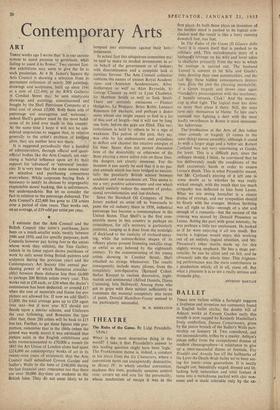Contemporary Arts
ART
THREE weeks ago I wrote that 'it is our curious system to assist promise to germinate, while failing to assist it to flower.' Two current Lon- don exhibitions may seem to give the lie to such pessimism. At 4 St. James's Square the Arts Council is showing a selection from its permanent collection of nearly 200 paintings. drawings and sculptures, built up since 1946 at a cost of £22,400; at the RWS Galleries in Conduit Street may be seen ninety-one drawings and paintings commissioned and bought by the Shell Petroleum Company at a total cost' of about £3,000. Both these acts of patronage are courageous and welcome— indeed Shell's gesture must be the most hand- some of its kind ever made in this country At the same time I hope it will not be con- sidered ungracious to suggest that, in relation generally to the artist's problem of keeping alive, they are neither here nor there.
It is suggested periodically that a handful of administrators, through official and quasi- official bodies like the Arts Council, are exer- cising a baleful influence upon art by their support for 'advanced' or 'extremist' tenden- cies. It is very true that the same names recur on selection and purchasing committees everywhere. While corporate buying finds it necessary to justify its choices by impregnably respectable moral backing, this is unfortunate, but understandable. But let us consider the fact in relation to the patronage disbursed. The Arts Council's £22,400 has gone to 128 artists over a period of nine years. That works out, on an average, at £19-odd per artist per year.
I estimate that the Arts Council and the British Council (the latter's purchases have been on a much smaller scale, mostly between 1946 and 1950, and for specific purposes; both Councils however pay hiring fees to the artists whose work they exhibit), the Tate Gallery (which in its latest report shows purchases of work by only seven living British painters and sculptors during the previous year) and the Contemporary Art Society (the annual pur- chasing power of which fluctuates consider- ably) between them disburse less than £6,000 to perhaps 200 British artists every year. This works out at £30 each; or £20 when the dealer's commission has been deducted; or around £15 when the cost of materials and frame for one picture are allowed for. If now we add Shell's £3,000, the total average goes up to £30 again (less tax)—but if next year ICI should not decide upon a similar scheme, and Unilevers the year following, and Bowaters the year after that, these 200 artists will be back to £15 less tax. Further, to get these figures into pro- portion, remember that in the 1860s (when the pound was worth more) it was estimated that picture sales in the English exhibitions and sales roomstamounted to £70,000 a month (in 1865 the Art Union of London alone had spent £324,000 on contemporary works of art in its twenty-nine years of existence); that the Arts Council itself subsidised Covent darden and Sadler's Wells to the tune of £340,000 during the last financial year; remember too that there are over 50,000 day-time art students in the British Isles. They do not seem likely to be
tempted into extremism against their better judgement.
In actual fact this ubiquitous committee may be said to make its modest investments in ail on behalf of the government or of industry with discrimination and a complete lack of partisan fervour. The Arts Council collection contains the names of sixteen Royal Acadcmi cians and Associate Academicians; Albei Rutherston as well as Alan Reynolds, Si' George 'Clausen as well as Lynn Chadwick Sir Matthew Smith as well as lack Smith There are certainly omissions — France' Hodgkins, Le Brocquy, Brian Robb, Leonard Rosoman for example, and perhaps a dozen more whom one might expect to find in a list of this sort of length—but it will not be long one feels, before the gaps are filled. This very catholicism is held by others to be a sign of weakness. The patron of the past, they say. was able by his enthusiasms and prejudices to deflect and channel the creative energies of his time. Space does not permit discussion here of the desirability or otherwise of the State playing a more active role on these lines the dangers. arc clearly immense. For the Moment it can surely be said that it is no pas- sive attitude which has here bridged so success- fully the peculiarly British schism between academic and non-academic art. This seems to me a very positive achievement and one which should usefully reduce the number of profes- sional revolutionaries and last-ditchers.
Since the Standard Oil Company of New Jersey packed an artist off to Venezuela to paint the oil industry there in 1938, industrial patronage has become a commonplace in the United States. That Shell's is the first com- parable move in this country is perhaps no coincidence, for oil's territory is particularly pictorial, ranging as it does from the nostalgia of dockland to the rusticity of orchard-spray- ing, while the science-fiction shapes of its refinery plants present frowning metallic crags as awful as any, beloved by the eighteenth century. To the commissioning of the young artists showing in Conduit Street,. Shell attached no strings whatsoever. The results consequently include many idioms, from the completely non-figurative (Bernard Cohen. Stefan Knapp) to realism decorative, night-, marish and sentimental (Alfred Daniels, Diana Cumming, Iola Hallward). Among those who got to grips with their subject sufficiently to transmute the material completely into terms of paint, Donald Hamilton-Fraser seemed to me particularly successful. M. H. MIDDLETON


































 Previous page
Previous page